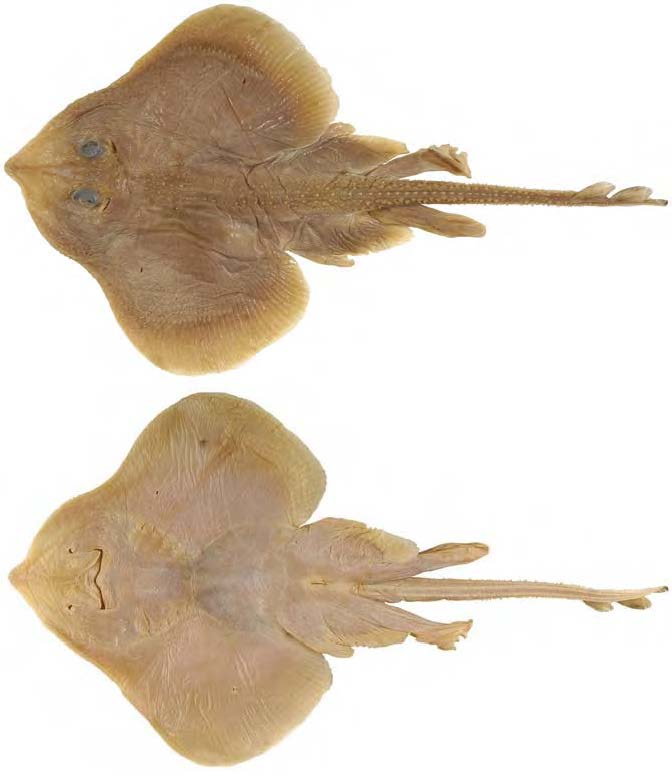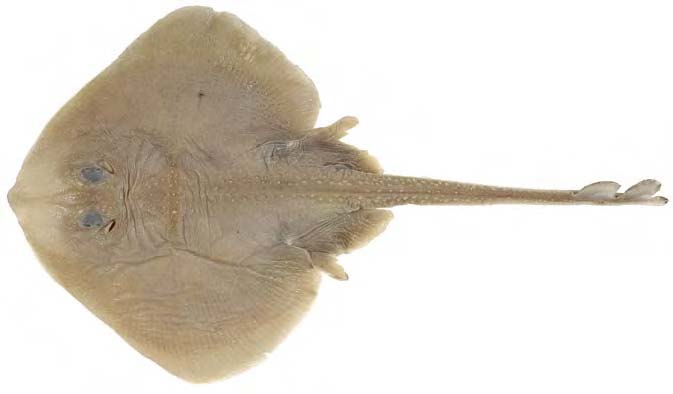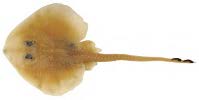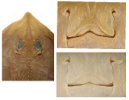Leucoraja pristispina
Last, Stehmann & Séret, 2008
Sawback skate
Classification: Elasmobranchii Rajiformes Rajidae
Reference of the original description
Leucoraja pristispina sp. nov., a new deepwater skate from Western Australia. CSIRO Marine and Atmospheric Research Paper, 21, 145–154
Leucoraja pristispina sp. nov., a new deepwater skate from Western Australia. CSIRO Marine and Atmospheric Research Paper, 21, 145–154
Image of the original description

Leucoraja pristispina sp. nov, adult male holotype (CSIRO CA 3905, 362 mm TL, preserved): A, dorsal surface; B, ventral surface. In: Last, P.R. & Stehmann, M. & Séret, B. 2008 Leucoraja pristispina sp. nov, a new deepwater skate from Western Australia. CSIRO Marine and Atmospheric Research Paper, 21: 145-154

Leucoraja pristispina sp. nov, adult male holotype (CSIRO CA 3905, 362 mm TL, preserved): A, dorsal surface; B, ventral surface. In: Last, P.R. & Stehmann, M. & Séret, B. 2008 Leucoraja pristispina sp. nov, a new deepwater skate from Western Australia. CSIRO Marine and Atmospheric Research Paper, 21: 145-154
Types
Leucoraja pristispina
Holotype: CSIRO: CA 3905; Paratype: CSIRO: H 6420-06; CSIRO: H 6420-05; CSIRO: H 6420-03; CSIRO: H 6420-04; CSIRO: H 6420-01; CSIRO: H 6420-02; CSIRO: H 1649-1; CSIRO: H 2025-1; CSIRO: H 1636-04; CSIRO: H 1636-02; CSIRO: CA 4402; CSIRO: CA 4370; CSIRO: CA 4342; CSIRO: CA 4333; CSIRO: CA 3934; CSIRO: H 2026-1; CSIRO: CA 4403; CSIRO: CA 4339; WAM: P 28072-010; WAM: P 28086-005; WAM: P 28058-005;
Leucoraja pristispina
Holotype: CSIRO: CA 3905; Paratype: CSIRO: H 6420-06; CSIRO: H 6420-05; CSIRO: H 6420-03; CSIRO: H 6420-04; CSIRO: H 6420-01; CSIRO: H 6420-02; CSIRO: H 1649-1; CSIRO: H 2025-1; CSIRO: H 1636-04; CSIRO: H 1636-02; CSIRO: CA 4402; CSIRO: CA 4370; CSIRO: CA 4342; CSIRO: CA 4333; CSIRO: CA 3934; CSIRO: H 2026-1; CSIRO: CA 4403; CSIRO: CA 4339; WAM: P 28072-010; WAM: P 28086-005; WAM: P 28058-005;
Description :
Citation: Leucoraja pristispina Last, Stehmann & Séret, 2008: In: Database of modern sharks, rays and chimaeras, www.shark-references.com, World Wide Web electronic publication, Version 01/2026
Please send your images of "Leucoraja pristispina" to info@shark-references.com

Dorsal surface of Leucoraja pristispina sp. nov. primary female paratype (CSIRO H 6420–05, 351 mm TL, preserved). In: Last, P.R. & Stehmann, M. & Séret, B. 2008 Leucoraja pristispina sp. nov, a new deepwater skate from Western Australia. CSIRO Marine and Atmospheric Research Paper, 21: 145-154

Dorsal surface of Leucoraja pristispina sp. nov. primary female paratype (CSIRO H 6420–05, 351 mm TL, preserved). In: Last, P.R. & Stehmann, M. & Séret, B. 2008 Leucoraja pristispina sp. nov, a new deepwater skate from Western Australia. CSIRO Marine and Atmospheric Research Paper, 21: 145-154
Common names
 Sawback skate
Sawback skate
 Sawback skate
Sawback skate
Short Description
Original diagnosis after LAST, STEHMANN & SÉRET, 2008 [3315]: A medium-sized species of Leucoraja (to 40 cm TL) with the following combination of characters: disc narrow, inverted heart-shaped to subcircular with broadly rounded apices, width 54–60% TL, 1.1–1.2 times its length; snout angle 90–104°; tail elongate, tapering, length 1.0–1.1 times distance from snout tip to rear of cloaca, relatively slender, width 1.7–1.9 times height at its midlength, 1.7–1.9 times at first dorsal-fin origin; pre-upper jaw length 13–14% TL, 1.7–2.0 times internasal width; ventral head length 25– 28% TL; snout length 2.7–3.4 times interorbital width; orbit diameter 88–100% interorbital width; first dorsal fin usually connected to second dorsal fin, its height 1.8–2.6 in its base length; distance from first dorsal-fin origin to tail tip 2.1–2.7 times first dorsal-fin base length, 1.6–4.3 times caudal-fin length; pelvic fins of medium size, length of posterior lobe of adult males 17–20% TL, length of anterior lobe 61–70% of posterior lobe; adult clasper relatively short and stout, 21–24% TL, connected to pelvic-fin inner margin at about 38–46% of its length from cloaca; dorsal disc very spiny, almost wholly covered with fine denticles, thorns and thornlets; nucho–scapular thorn patch dense and triangular; rostral and interorbital thorns present in all but smallest juveniles; malar thorn patch well developed and located at level of orbit and spiracle; alar patch elongate, narrow, only slightly shorter than prespiracular length; tail with multiple irregular thorn rows (thorns of median row usually smaller than those of adjacent lateral rows); total pectoral radials 61–64; trunk centra 26–28; predorsal centra 85–91; total centra about 121–127; tooth rows in upper jaw 47–55; uniform pale greyish or brownish dorsally, uniformly whitish ventrally; ventral sensory pores not black edged; dorsal fins of juveniles pale based with black outer margins (less distinct in adults).
Original diagnosis after LAST, STEHMANN & SÉRET, 2008 [3315]: A medium-sized species of Leucoraja (to 40 cm TL) with the following combination of characters: disc narrow, inverted heart-shaped to subcircular with broadly rounded apices, width 54–60% TL, 1.1–1.2 times its length; snout angle 90–104°; tail elongate, tapering, length 1.0–1.1 times distance from snout tip to rear of cloaca, relatively slender, width 1.7–1.9 times height at its midlength, 1.7–1.9 times at first dorsal-fin origin; pre-upper jaw length 13–14% TL, 1.7–2.0 times internasal width; ventral head length 25– 28% TL; snout length 2.7–3.4 times interorbital width; orbit diameter 88–100% interorbital width; first dorsal fin usually connected to second dorsal fin, its height 1.8–2.6 in its base length; distance from first dorsal-fin origin to tail tip 2.1–2.7 times first dorsal-fin base length, 1.6–4.3 times caudal-fin length; pelvic fins of medium size, length of posterior lobe of adult males 17–20% TL, length of anterior lobe 61–70% of posterior lobe; adult clasper relatively short and stout, 21–24% TL, connected to pelvic-fin inner margin at about 38–46% of its length from cloaca; dorsal disc very spiny, almost wholly covered with fine denticles, thorns and thornlets; nucho–scapular thorn patch dense and triangular; rostral and interorbital thorns present in all but smallest juveniles; malar thorn patch well developed and located at level of orbit and spiracle; alar patch elongate, narrow, only slightly shorter than prespiracular length; tail with multiple irregular thorn rows (thorns of median row usually smaller than those of adjacent lateral rows); total pectoral radials 61–64; trunk centra 26–28; predorsal centra 85–91; total centra about 121–127; tooth rows in upper jaw 47–55; uniform pale greyish or brownish dorsally, uniformly whitish ventrally; ventral sensory pores not black edged; dorsal fins of juveniles pale based with black outer margins (less distinct in adults).
Remarks
shark-references Species-ID=3497;
shark-references Species-ID=3497;


















